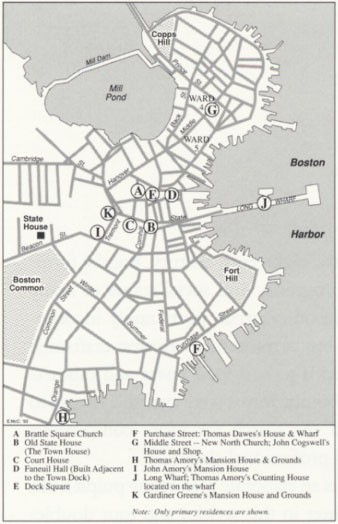
Sectional adaptation derived from A New Plan of Boston From Actual Surveys By Osgood Carleton, With Corrections, Additions and Improvements, Boston, 1800. (Adaptation, Eliza McClennen.)
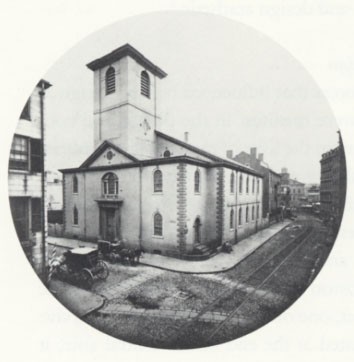
Brattle Square Church, Boston, 1772–1773. Photograph by Josiah Johnson Hawes, Boston, 1859. Brattle Square Church was centrally located near the Town Market, Dock Square, Faneuil Hall, and the Province House. (Courtesy, Society for the Preservation of New England Antiquities.)
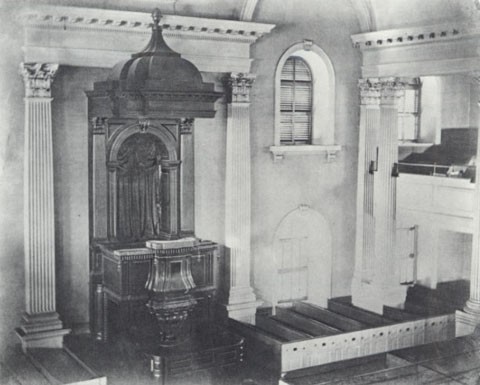
Interior of Brattle Square Church, photo 1866–1872. (Courtesy, Society for the Preservation of New England Antiquities.)
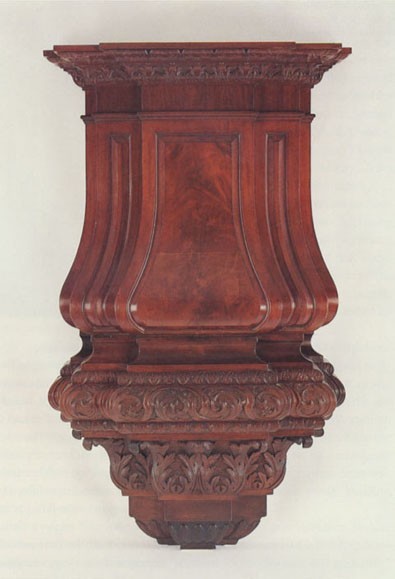
Pulpit attributed to William Crafts and William Burbeck, Boston, 1772–1773. Mahogany and mahogany veneer with white pine. H. 83 5/8", W. 50 1/8", D. 18 3/4". (Courtesy, Society for the Preservation of New England Antiquities, acc. 1975.195, and the Massachusetts Historical Society, acc. MHS 255 [base]; photo, David Bohl.)
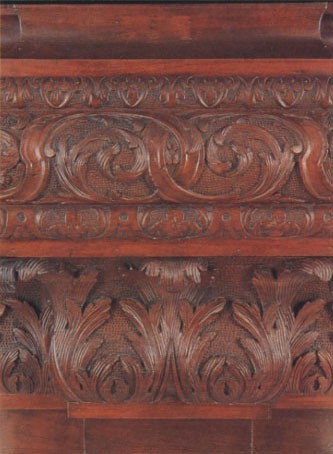
Detail of the carving on the pulpit from Brattle Square Church. (Photo, David Bohl.)
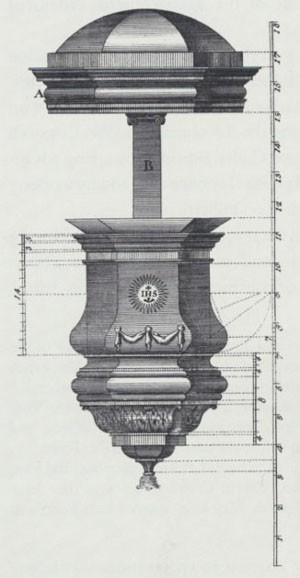
Design for a pulpit illustrated on pl. 112 in Batty Langley’s The City and Country Builder’s and Workman’s Treasury of Designs (1740; reprint, London, 1756). (Courtesy, Society for the Preservation of New England Antiquities.)
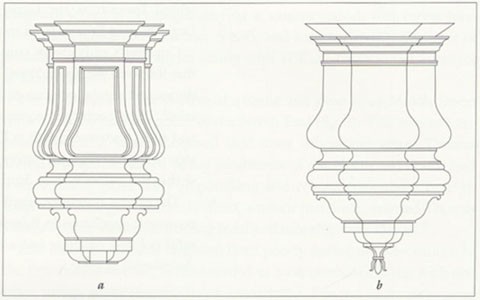
Comparison of the pulpit from (a) Brattle Square Church and (b) pl. 112 in Langley’s Treasury. (Drawing, Eliza McClennen.)
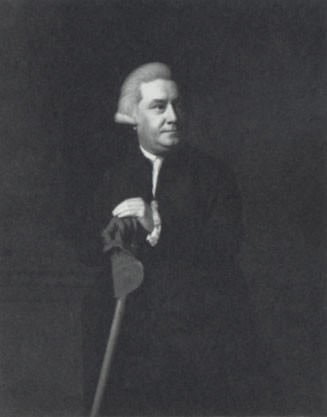
John Singleton Copley, Thomas Amory II, Boston, oil on canvas, ca. 1770-1772. H. 49 3/4", W. 39 1/2". (Courtesy, Corcoran Gallery of Art, Museum purchase, funds provided by William Wilson Corcoran, acc. 1989.22.)

Desk attributed to John Cogswell, Boston, 1780–1784. Mahogany with white pine. H. 42 3/4", W. 37 3/8", D. 19 5/8". Only two serpentine front bombé desks are known. (Private collection; photo, David Bohl.)
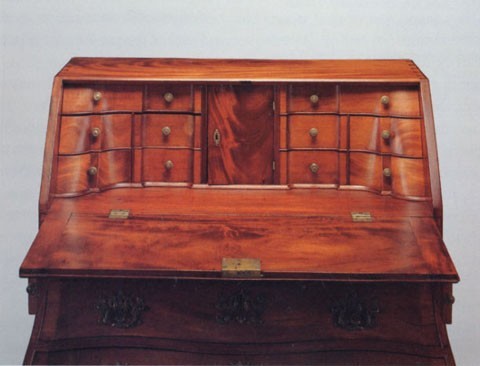
Detail of the interior of the desk illustrated in fig. 9. The distinctive amphitheater design occurs on only three other desks, all of bombé form. (Photo, David Bohl.)
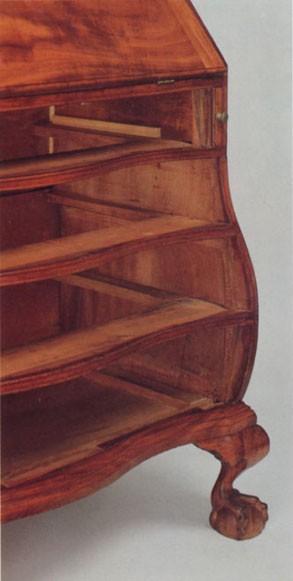
Detail of the case construction of the desk illustrated in fig. 9. (Photo, David Bohl.)
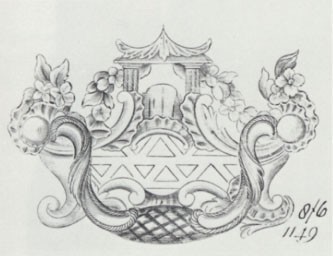
Brass backplate and handle no. 1149 illustrated on pl. 55 in an anonymous brass founder’s catalogue, England, n.d., ca. 1770–1780. Amory sold hardware and probably owned catalogues from English manufacturers who offered this pattern or a similar one. (Courtesy, Winterthur Library: Printed Book and Periodical Collection.)
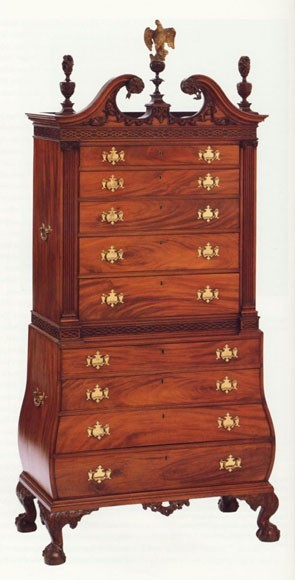
Chest-on-chest signed John Cogswell with carving attributed to the Skillin shop, Boston, 1782. Mahogany with white pine. H. 97", W. 44 1/4", D. 23 1/2". (Courtesy, Museum of Fine Arts, Boston. Reproduced with permission. © 2000 Museum of Fine Arts, Boston. All rights reserved. acc. 1973.289.)
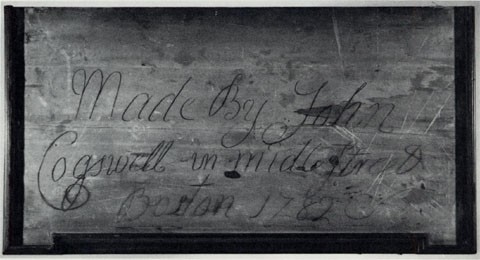
Inscription on the top board of the lower case of the chest-on-chest illustrated in fig. 13. (Photo, Museum of Fine Arts, Boston.)

Detail of the pediment of the chest-on-chest illustrated in fig. 13. (Photo, Museum of Fine Arts, Boston.)
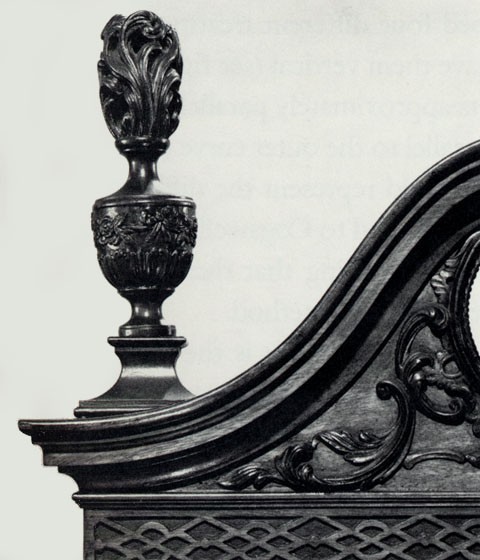
Detail of the finial, fret, and scrollboard carving on the chest-on-chest illustrated in fig. 13. (Photo, Museum of Fine Arts, Boston.)
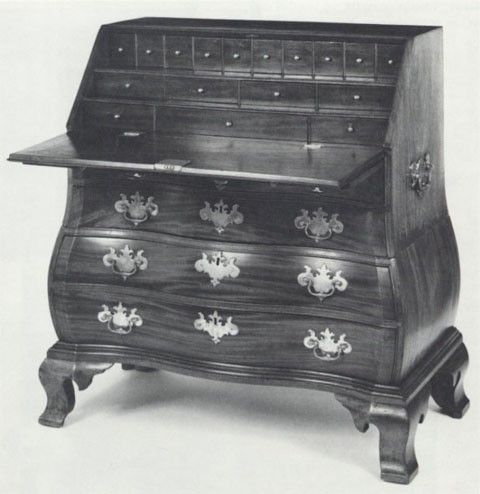
Desk attributed to John Cogswell, Boston, 1770–1780. Mahogany with white pine. H. 42 1/2", W. 40 1/8", D. 20 3/4". (Private collection; photo, Will Brown.)
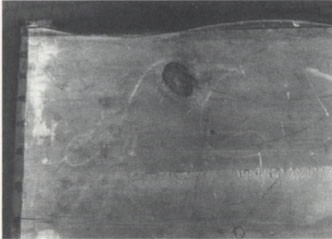
Detail of the chalk initials “JC” on the top board of the lower case of the desk illustrated in fig. 17. (Photo, Joseph Godla.)
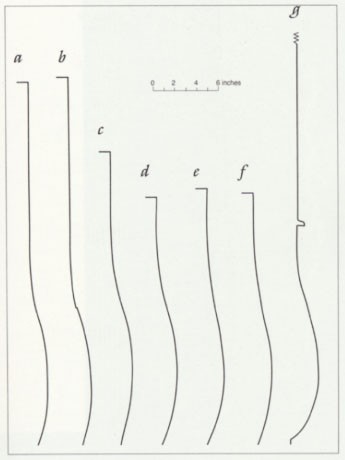
Comparative profiles of the sides of (a) Amory desk, fig. 9; (b) two-part desk, fig. 17; (c) chest-on-chest signed “John Cogswell,” fig. 13; (d) Storer chest of drawers, fig. 33; (e) chest of drawers, fig. 43; (f) chest of drawers, fig. 40; (g) desk-and-bookcase signed “Benj. Frothingham” and “BF 1753” (Diplomatic Reception Rooms, U.S. Department of State, not illustrated). (Drawing, Eliza McClennen.)
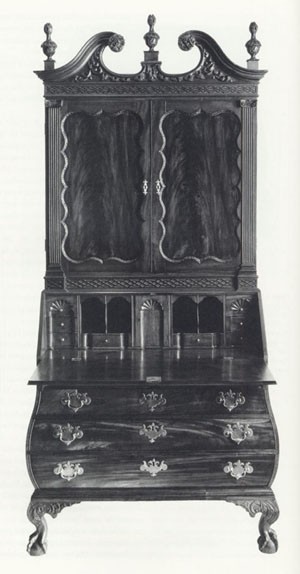
Desk-and-bookcase attributed to John Cogswell, Boston, 1786. Mahogany with white pine. H. 99 1/4", W. 45 1/8", D. 22 7/8". This desk-and-bookcase has two inscriptions, “1786 AD” and “Jackson [?].” (Courtesy, Winterthur Museum, acc. 59.3414.)
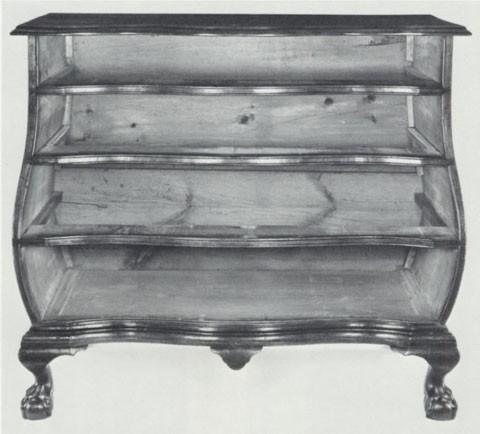
Detail of the case construction of the chest of drawers illustrated in fig. 41. (Photo, Art Institute of Chicago.)
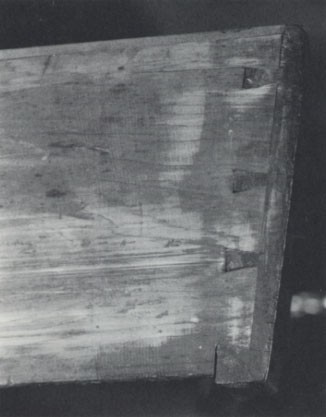
Detail of the drawer construction of the chest of drawers illustrated in fig. 41. (Photo, Art Institute of Chicago.)
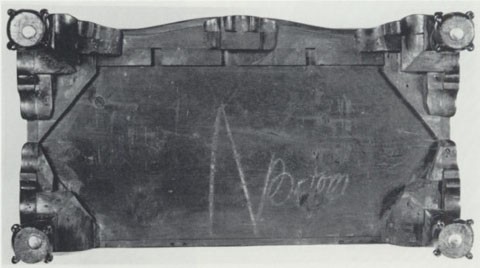
Detail of the base construction and inscriptions on the desk-and-bookcase illustrated in fig. 24. (Photo, Winterthur Museum.)
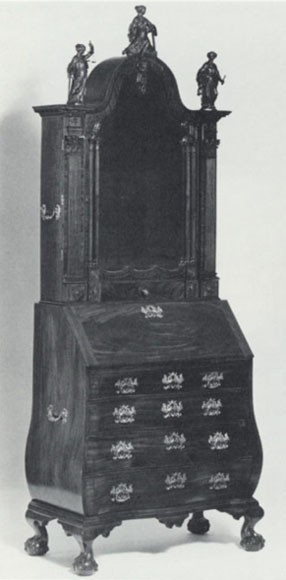
Desk-and-bookcase attributed to John Cogswell with figures attributed to the Skillin shop, Boston, 1780–1785. Mahogany with white pine. H. 95 1/2", W. 37 5/16", D. 20". (Courtesy, Winterthur Museum, acc. 56.23.)

Desk-and-bookcase attributed to John Cogswell with carving possibly by William Burbeck, Boston, 1780–1785. Mahogany with white pine. H. 82 1/16", W. 37 1/4", D. 20 9/16". (Courtesy, Winterthur Museum, acc. 57.1396.)

Detail of the writing compartment of the desk-and-bookcase illustrated in fig. 25. (Photo, Winterthur Museum.)
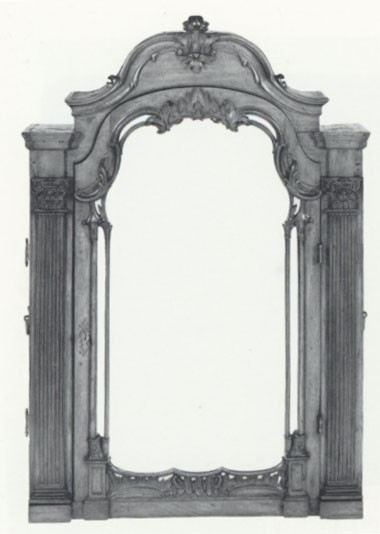
Detail of the upper case of the desk-and-bookcase illustrated in fig. 25. (Photo, Winterthur Museum.)

Detail of the carving at the top of the door and on the ogee head of the desk-and-bookcase illustrated in fig. 25. (Photo, Winterthur Museum.)
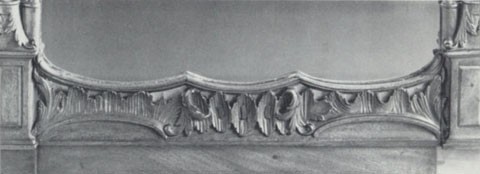
Detail of the carving on the lower rail of the door of the desk-and-bookcase illustrated in fig. 25. (Photo, Winterthur Museum.)
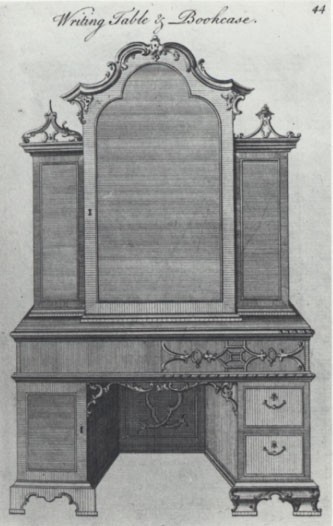
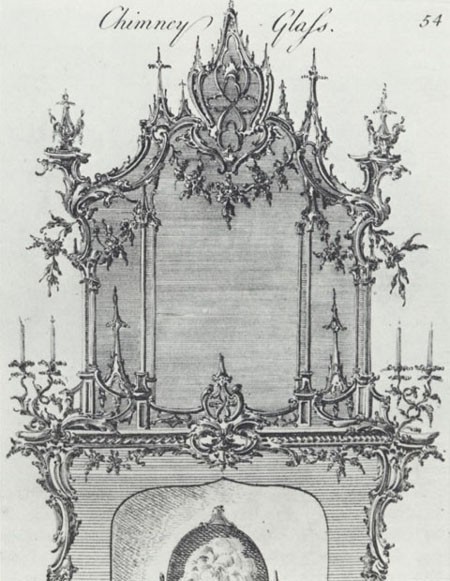
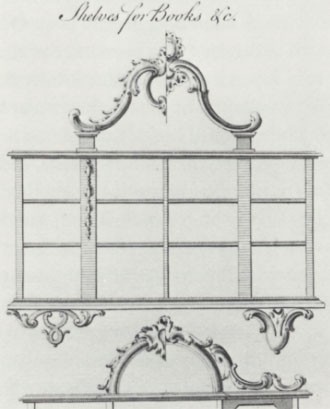
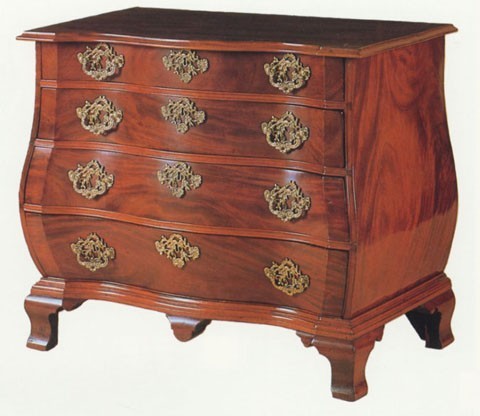
Chest of drawers attributed to the shop of John Cogswell, Boston, 1780–1795. Mahogany with white pine. H. 30 7/16", W. 35 7/8", D. 20". (Courtesy, Diplomatic Reception Rooms, U.S. Department of State, acc. 69.103; photo, Will Brown.)
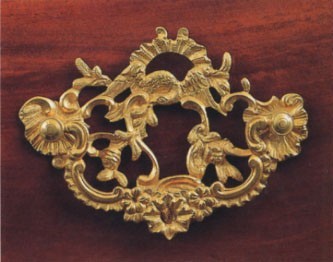
Detail of the hardware on the chest illustrated in fig. 33. The brasses were regilded in 1989. (Photo, Will Brown.)
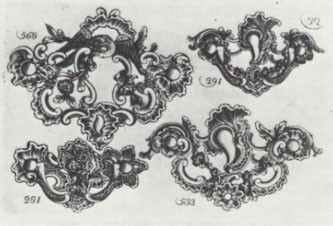
Brass patterns illustrated on pl. 32 of Brass Founders Catalog of Accessories for Cabinet-makers and Upholsterers, England, 1770s. For the brass of fig. 33, the backplate is derived from no. 568 and the handle from no. 533. (Courtesy, Winterthur Library: Printed Book and Periodical Collection.)

Chest of drawers attributed to the shop of John Cogswell, Boston, 1780–1795. Mahogany with white pine. H. 31 1/2", W. 35 3/4", D. 20 1/4". (The Dietrich American Foundation on loan to The Metropolitan Museum of Art, acc. L.1980.29; photo, The Metropolitan Museum of Art.)
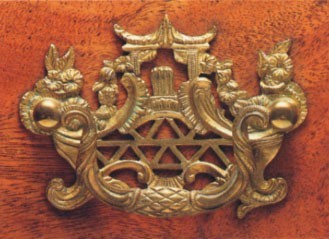
Detail of a brass on the chest illustrated in fig. 36. (Courtesy, Dietrich American Foundation; photo, Will Brown.)
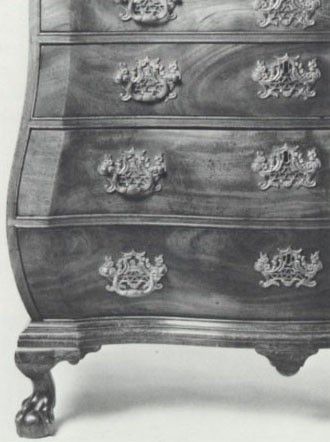
Detail of the case and left front foot of the chest illustrated in fig. 36. (Courtesy, Dietrich American Foundation; photo, Will Brown.)

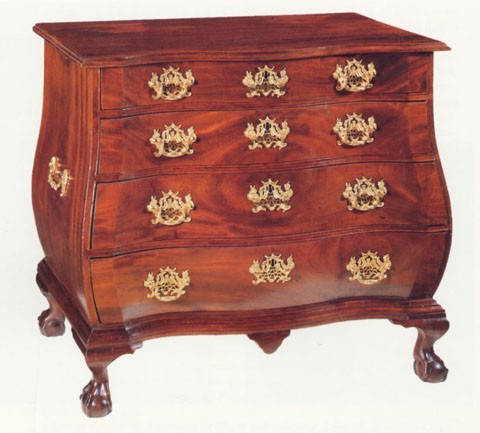
Chest of drawers attributed to the shop of John Cogswell, Boston, 1780–1795. Mahogany with white pine. H. 31 1/4", W. 36 1/8", D. 20 1/4". The chinoiserie hardware is replaced based on scars left from the originals. (Private collection; photo, Richard Cheek.)
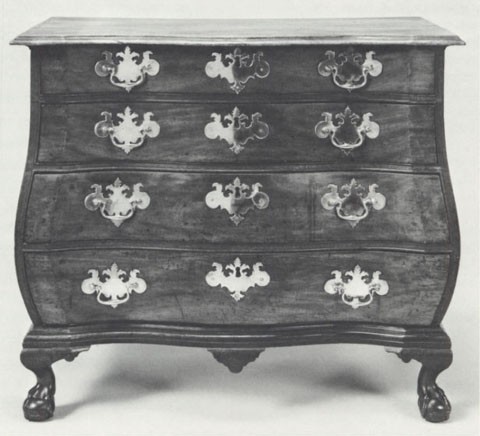
Chest of drawers attributed to the shop of John Cogswell, Boston, 1780–1795. Mahogany with white pine. H. 31 3/8", W. 36 1/8", D. 20". This chest is the only one of the group that survives with remnants of the original finish. (Courtesy, Art Institute of Chicago, Helen Bowen Blair Fund, acc. 1979.499, photo copyright 1992. All rights reserved, ©The Art Institute of Chicago.)
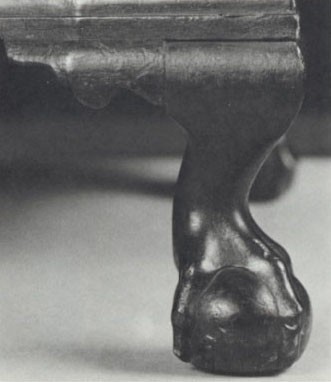
Detail of the foot of the chest illustrated in fig. 41. (Photo, Art Institute of Chicago.)
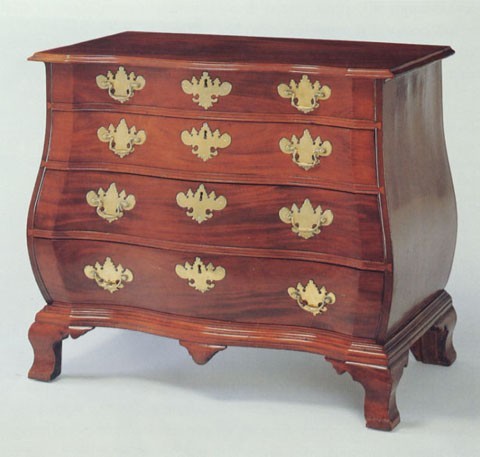
Chest of drawers attributed to the shop of John Cogswell, Boston, 1783-1795. Mahogany with white pine. H. 30 1/4", W. 35 3/4", D. 21". (Private collection; photo, David Bohl.)
During the second half of the eighteenth century, bombé furniture was a signal expression of the prosperity and social status of many wealthy Bostonians. Cabinetmakers in other urban ports rarely incorporated the bombé shape in their work, but at midcentury Boston craftsmen embraced the new design and adapted it to suit local tastes and cabinetmaking practices. By 1775, a variety of bombé forms were available owing to competition between tradesmen and the search for more conspicuous totems of wealth by the merchant and professional classes.
Among the surviving bombé forms is an elaborate mahogany pulpit from Brattle Square Church (see figs. 3–5 later in this article) and four double-serpentine front bombé case pieces owned by merchant congregants. The pulpit, like other Boston bombé case pieces from the 1750–1775 period, has its swell placed low on the front and sides. Those forms from the 1775–1795 period evolved to combine less abrupt bottom-heavy shaping and double-serpentine facades.
The latter period encompasses the prime working years of John Cogswell (1738–1819), an Ipswich, Massachusetts, cabinetmaker who moved to nearby Boston about 1760. Cogswell’s name has long been associated with Boston bombé furniture because of a magnificent chest-on-chest that bears his signature (see fig. 13 later in this article), but little has been written about his life and work. This article examines Cogswell’s career and thirteen pieces of bombé furniture now attributed to his shop. The impact of the Revolution on Boston bombé design is explored, including the increasing French influence on the local culture and design aesthetic.[1]
Brattle Square Church and Bombé Design
The social, economic, and political forces that influenced bombé design at the beginning of Cogswell’s career were manifest in the design and construction of Brattle Square Church and in the lives of many of its members. Four pieces attributed to Cogswell’s shop were made for wealthy merchants who were members of that church: Thomas Amory, Joseph Barrell, Ebenezer Storer, and Gardiner Greene. Thomas Dawes (1731–1809), the designer and builder of the church, and at least three other congregants owned bombé furniture by other Boston cabinetmakers. In addition, the church had an imposing bombé pulpit, one of only three known to survive from the colonies. Prominently situated at the end of the central aisle, it was an emblem deliberately selected to reflect the elevated status of the members.[2]
The first church in Brattle Square (1699) was known as the “Manifesto Church” for the congregation’s inaugural proclamation of independence from religious dogma. By the middle of the eighteenth century, it was the leading social and philosophical forum for Boston’s Congregationalist elite and, subsequently, a center of revolutionary resistance. Its congregation included merchants, politicians, lawyers, doctors, and many other wealthy and prominent Bostonians such as James Bowdoin, John Hancock, Samuel Adams, John Adams, Dr. Joseph Warren, William Cooper, Josiah Quincy, Samuel Otis, Joseph Barrell, Ebenezer Storer, Theodore Lyman, Thomas and Charles Bulfinch, John Erving, John and Jonathan Amory, John Fayerweather, Daniel Oliver, Thomas Boylston, and Peter Chardon.[3]
The church also functioned as a social center, and its architecture and furnishings reflected the wealth and taste of the congregation. A visiting Frenchman wrote, “the church is the great theater where they [American ladies] attend, to display their extravagance and finery. There they come dressed off in the finest silks, and overshadowed with a profusion of the most superb plumes. The hair . . . is raised . . . to an extravagant height, somewhat resembling the manner in which the French ladies wore their hair some years ago.”[4]
By 1772, the old church building had become too small and dilapidated for the growing congregation. On February 6, 1772, John Hancock, seeking to curry the favor of the congregants, offered to contribute £1000 towards the erection of a new church provided that it was built on the site of the existing church. This location was central to the seats of government and the commercial districts (fig. 1). Construction of the new church (on the foundations of its predecessor) and the commission of its extravagant bombé pulpit occurred during the early 1770s, despite general economic and political turmoil. The church was the only major public building erected in Boston between 1765 and 1785.[5]
Painter John Singleton Copley (1738–1815) and mason/master builder Thomas Dawes both submitted designs for the church to the building committee. Copley’s plan, although “admired for its elegance and grandeur,” was rejected because of construction costs, and the contract for designing and building the church went to Thomas Dawes, a longtime friend and political crony of John Hancock. Dawes laid the cornerstone on June 23, 1772, and by July of the following year the church was completed (figs. 2, 3). The church commemorated Hancock’s generosity by inscribing his name on an exterior quoin.[6]
Hancock’s donation paid for the window glass, bell, pulpit, crimson silk damask pulpit furniture, deacon’s seat, communion table, and seats for “the accommodation of poor widows and others belonging to the society, who are reputable persons and unable to furnish themselves with seats, &c.” By personally selecting these lavish furnishings, Hancock focused attention on his largesse and raised his status in the church and society. Not coincidentally, Hancock’s pew in the new church was adjacent to the pulpit at the head of the central aisle.[7]
The interior was “richly finished [in] the Corinthian order,” and the pulpit was “of mahogany, . . . the most elegantly finished work in town” (fig. 3). Although the soundboard does not survive, the pulpit is one of the most fully developed examples of late baroque Boston woodwork (figs. 4, 5). The overall design, based on a three-dimensional hexagon, is derived from Batty Langley’s City and Country Builder’s and Workman’s Treasury of Designs (1740) (fig. 6). The rear of the pulpit from Brattle Square Church is open, and the facade has parallel returns on each side creating a reiterative bombé shape (fig. 7). The carving on the large ogee molding at the base of the pulpit is also derived from Langley’s design, but the strapwork acanthus on the large torus molding is more reminiscent of late-seventeenth-century carving (fig. 5). Langley’s Treasury was one of the design books advertised most frequently by Boston booksellers during the middle of the eighteenth century and was the primary source of designs for churches and church furniture. Dawes owned at least twelve architectural books including the Treasury, and his copy may have provided the inspiration for the pulpit.[8]
The raised panels of the pulpit initially appear to be joined in a conventional manner; however, the mahogany panels are carved from 4 1/2" to 5"-thick planks, and each is mitered at the corners and fastened with nails. Both the bevels and bordering quarter-round molding are cut from the solid. Only the central portion of the front panel is veneered (fig. 4).
According to one church pastor, “a temporary pine pulpit was first erected, that [the bombé pulpit] which was engaged by him [John Hancock] of Mr. Crafts not being finished when the house was occupied.” Crafts also did approximately half of the overall carpentry work for the church. “Mr. Crafts” was probably William Crafts (1736–1800), a Boston house joiner who frequently worked with Thomas Dawes. Crafts held a series of minor town offices, serving at various times with Thomas Dawes and Joseph Barrell. Crafts built outbuildings for and made improvements to Hancock’s houses on Beacon Hill and Queen Street over the period of a decade and made “3 elbow pieces, 1 Seat, 1 Shelf, 1 Draw, and 3 footstools” for Hancock’s use at Brattle Square Church. Crafts’s association with Dawes and Hancock underscores the importance of social and business connections for eighteenth-century artisans. Such relationships undoubtedly influenced Crafts’s receiving the commission for the pulpit.[9]
Circumstantial evidence suggests that William Burbeck (Burbank) (1716–1785) may have carved the pulpit (figs. 4, 5). Burbeck was working in Boston by 1735, and during his career he collaborated on various projects with Dawes, Crafts, and Hancock. He also held minor town offices and belonged to some of the same influential organizations as these men, including the Ancient and Honorable Artillery Company, the Lodge of St. Andrew, the Massachusetts Charitable Society, and the Sons of Liberty. Like Dawes, Burbeck owned several English architectural design books including William Halfpenny’s Useful Architecture (1752), William Salmon’s London Art of Building (1734), James Gibbs’s A Book of Architecture (1728), and three separate publications by Batty Langley, one of them probably the Treasury.[10]
The relationships between Burbeck, Crafts, Dawes, and Hancock went beyond those of artisan and patron, for they collaborated on several important public projects. For Burbeck, Crafts, and Dawes, such projects represented steady pay and an opportunity to interact with potential patrons. Furthermore, public service meant increased social standing and power in the community. Although these alliances clearly benefited the participants financially, the collaboration also resulted in several exceptional works of architecture.
As the most conspicuous and costly fixture in Brattle Square Church, the pulpit undoubtedly reflected the taste of the building committee and other influential congregants. The baroque curves and bold molding profiles of the pulpit certainly were comparable to those in the most fashionable Boston bombé furniture; yet, the reliance on thirty-year-old English Palladian designs expressed the fundamental conservatism of Boston’s pre-Revolutionary craftsmen and merchants.
John Cogswell
John Cogswell was one of the few outsiders to break into Boston’s relatively closed artisan community. During the early 1750s, he probably trained with a member of the Gooding family, a sixth-generation artisan family centered principally around Charlestown but with members also living in Boston and Cambridge. Cogswell married Abigail Gooding in 1762. The association with the Goodings probably gave Cogswell entrance into Boston’s artisan community. Other social contacts may have been provided by Cogswell’s father, Francis. A graduate of Harvard College and a moderately successful merchant, Francis had extensive business contacts in Nova Scotia, Quebec, Boston, and other New England seaports. He also represented Ipswich at the General Court of the Massachusetts Provincial Legislature in Boston from 1751 to 1754.[11]
Cogswell’s early career coincided with the severe economic depression that followed the Seven Years’ War. Higher taxes, rising inflation, and new duties and regulations caused a dramatic rise in the number of artisans on relief. These problems worsened during the Revolutionary War. Cogswell and allied tradesmen, such as Dawes and Crafts, subsisted by taking advantage of social, religious, fraternal, and political connections and by working within the caucus system. Burbeck relied on military pay.[12]
The caucus system emerged during the 1730s as a response to worsening economic conditions in Boston, but by midcentury it had become a powerful political machine and a means of soliciting patronage. John Adams described it in 1763:
Caucas Clubb meets . . . in the Garrett of Tom Daw[e]s, the Adjutant of the Boston Regiment [Ancient and Honorable Artillery Company]. . . . There they smoke tobacco till you cannot see from one End of the Garrett to the other, . . . drink Phlip, . . . and . . . choose a Moderator, who puts Questions to the Vote regularly, and select Men, Assessors, Collectors, Wardens, Fire Wards, and Representatives are Regularly chosen before they are chosen in the Town. . . . They send Committees to wait on the Merchants Club and propose, and join, in the Choice of Men and Measures. Captn. Cunningham says they have often solicited him to go to these Caucas, they have assured him Benefit in his Business &c.[13]
Wealthy aristocrats held the most coveted town positions—as selectmen—but artisans and their political allies controlled many minor appointive offices. The most influential members of the Caucus Club functioned as ward bosses who secured votes during elections and helped “staff” town committees responsible for allocating funds with the “right tradesmen.” Through churches, fire and militia companies, social clubs, mercantile organizations, and a variety of town offices, the Caucus Club influenced almost every group of voters in town. Moreover, it gave artisans the chance to interact with selectmen and other potential patrons.[14]
As leader of the Caucus Club, Dawes made certain that public funds went to trusted associates. By serving on town committees, such as the one appointed to consider his own “Scheem . . . for . . . preventing Chimneys taking fire,” Dawes secured commissions for himself (the town hired him to implement the committee’s recommendations) and other artisans in his circle.[15] Throughout his career, the small group of tradesmen he regularly worked with included Crafts, Burbeck, and Cogswell.
Although Boston-born tradesmen dominated the Caucus Club, Cogswell became involved shortly after his marriage. In 1763, the town appointed him constable, and the following year he participated in the annual “General Walk or Visitation of the Town” along with Dawes and merchants Ebenezer Storer, Edmund Quincy, and Timothy Newell. Cogswell’s service to the town was not continuous, but he held several important positions. In 1779, for example, the town instructed him, Dawes, and painter/joiner Thomas Crafts (William Crafts’s brother) “to procure Subscriptions to fortify the harbor.” Intermittently, from 1770 to 1818, Cogswell served at times as Scavenger (serving at various periods with carver John Welch and merchants Jonathan Amory and Joseph Barrell), Surveyor of Boards, Surveyor of Shingles (along with William Crafts), and Surveyor of Mahogany.[16]
On April 24, 1767, he purchased a house and shop at 49 Middle Street (now Hanover), in the center of the North End (fig. 1). This area encompassed Ward 4, where Cogswell held town offices and where Thomas Dawes was caucus leader. Many inhabitants of the North and South End were artisans, particularly shipbuilders and related tradesmen. In 1773, Cogswell’s younger brother William, a minor merchant, married Thomas Dawes’s sister, further cementing John’s relationship with Dawes.[17]
Like many tradesmen, Cogswell fared poorly during the Revolution. In the 1771 Boston tax list, he is recorded as a cabinetmaker living with one other voting age adult, probably a journeyman. His real estate assessment was £16 and the value of his “Stock in Trade” was £60, an average figure for successful cabinetmakers in that year. In 1780, he is listed as a “Trader,” having one “rateable poll [himself]” and £50 annual rent from his “Back House.” With his trade disrupted, Cogswell had to find an additional source of income. On July 24, 1782, he petitioned the Suffolk County Inferior Court:
That his business of a Cabinetmaker having almost failed, and the great loss he has met with by the depreciation of the Ennemey and the wanton depredations of the Ennemey when the Town was shut up, together with great sickness in his Family he has found himself under the necessity of opening a Shop for the Sale of West India Grocery Goods in order to support himself and his Family. . . . He shall experience but little profit unless he can obtain a License to retail Spirits . . . for his said Shop situated in Middle Street [see fig. 1].
The selectmen granted him an “Innholder & Retailer” license on August 28, 1782. The tax assessment for 1782 listed him as “Huxter,” probably referring to his retail grocery trade.[18] For most Boston artisans, financial recovery depended on the renewed trade of their primary clientele—established merchants and new entrepreneurs such as Joseph Barrell and Elias Hasket Derby of Salem. Despite Cogswell’s financial hardships, he secured at least one substantial commission shortly after the war: the costly chest-on-chest made for Derby in 1782 (see fig. 13).
Soon after his first wife’s death early in 1782, Cogswell married Abiel (Abiall) Page, daughter of shipwright Edward Page, and continued forging commercial alliances with mariners. In 1785, his oldest daughter, Sarah, married Abiel’s brother, Capt. Thomas Page, and Cogswell sold land on Bennett Street to Capt. John Skimmer. Cogswell may have used such connections to maintain a steady supply of groceries and other retail goods and to dabble in the venture cargo trade.[19]
In 1787, Cogswell was not listed as a cabinetmaker on the tax rolls, suggesting that the recovery of his trade was slow, but in 1788 he was. His assets grew during the 1790s; however, his tax valuations were less than those of cabinetmakers George Bright, Thomas Sherburne, and Gibbs Atkins. To supplement his income, Cogswell worked part-time as “surveyor of boards and shingles” from 1788 to 1818 and as “surveyor of mahogany” from 1799 to 1818. He died with an estate valued at $4,218.65, a figure indicative of moderate success.[20]
By the early 1780s, Cogswell had worked in Boston for more than twenty years. He, and at least one other unidentified cabinetmaker, updated traditional bombé forms by reducing the convex swell of the sides and fronts and by adding double-serpentine shaping to the facade. They adopted double-serpentine shaping about 1780, approximately the same time that Salem cabinetmakers began making case furniture with single-serpentine fronts. Imported English and French furniture with “commode” fronts and London design books, such as Thomas Chippendale’s Gentleman and Cabinet-Maker’s Director (1754) and Ince and Mayhew’s Universal System of Household Furniture (ca. 1762), probably inspired the serpentine shaping.[21]
No French furniture of commode form has been documented in Boston before the 1790s; however, interaction between Boston and French armed forces, economies, cultures, and political systems increased significantly during and after the war. Although John Hancock, Reverend Samuel Cooper of the Brattle Square Church, and John Adams had been avowed enemies of France, each played a key role in recasting the erstwhile “demons” as saviors and as valuable political and economic allies after 1776. Hancock was a commander of the unsuccessful French-American assault on British forces in Newport and frequently entertained French naval officers and seamen at his mansion. Cooper became best friends with General Lafayette, and Adams spent 1778 to 1780 in France.[22]
From 1777 through 1784, a squadron of the French navy was quartered in Boston harbor. The navy was one of the few sources of specie in a town cut off from access to British currency and credit. Enterprising young men, such as Joseph Barrell, made fortunes privateering and provisioning the French, much as Thomas Hancock, John Erving, and Charles Apthorp had built fortunes in the 1750s and 1760s by provisioning British forces in the series of wars with the French. Marquis de Chastellux, a wartime visitor to Boston, noted in his diary, “[On the Hercule] was a young man of eighteen, of the name of Barrel, who had been two months on board, that by living continually with the French, he might accustom himself to speak their language, which cannot fail of being one day useful to him.” William Burbeck, with his diverse skills, became the lead American fortifications engineer for Boston harbor, working throughout the war in close cooperation with French counterparts. His probate inventory taken in 1785 includes a French dictionary and several other French titles.[23]
The experience of merchant brothers John and Jonathan Amory was typical. Cut off by the war from their normal supplies of English credit and goods, they began trading with France and Belgium. John spent much of the war in Nantes, France, purchasing French fabrics and general merchandise that Jonathan resold in Boston. Returning home after the hostilities, John continued to import French dry goods for his customers and French furniture for himself. Evidence of growing affection for French goods is Ebenezer Storer’s order of November 12, 1779, to “Mr. Jonathan Williams, Merchant in Nantes,” for a variety of yard goods suitable for upholstering a coach, a “neat gold watch made by . . . Gregson, Watchmaker at Paris,” a French grammar book, a French dictionary, and other volumes. Years later, the Marquis de Chastellux recalled, “It is inconceivable how the stay of the [French] squadron has contributed to conciliate the two nations and to strengthen the connections which unite them. . . . The officers of our navy were every where received, not only as allies, but as brothers, . . . and they were admitted by the ladies of Boston to the greatest familiarity.”[24]
The customary excesses of wartime life and the sudden exposure to French values had a profound influence on traditional Boston society. As early as 1778, General Warren observed that “all manner of extravagance prevails here in dress, furniture, equipage and living,” and in 1779 Samuel Adams decried “that inundation of levity, vanity, luxury, dissipation.” Both men saw a single cause: the French presence.[25]
A whole new set of customs, affectations, and social clubs sprang up to amuse the nouveau riche. Perez and Sarah Morton and others founded the “Sans Souci Club,” modeling it on French manners, dancing, and entertainment. The club and the values it celebrated stood in sharp contrast to the simplicity and republican virtues to which Boston’s traditional leaders clung. The dialectic of this clash was to dominate Boston life, politics, and taste for the next twenty years.[26]
The rise of a new cosmopolitan merchant elite and Bostonians’ newfound taste for French art, literature, and culture created a fertile environment for artisans to develop and experiment with new forms and styles. Although the city’s elite continued to embrace the bombé form in the decade following the Revolution, the stage was set for cabinetmakers to refine their designs and construction methods and depart from the heavier bombé forms of the pre-Revolutionary period.
John Cogswell’s Bombé Furniture
Sometime between 1780 and 1784, Cogswell made a serpentine bombé desk for Boston merchant Thomas Amory, Jr. (1722–1784) (figs. 8, 9). The desk features an innovative commode front and has the faint initials “JC” written in chalk on the left fallboard support. Although they are difficult to execute, the double-serpentine shaping and broken-stripe figure of the drawer fronts created a dramatic sense of movement. In addition, the drawer fronts were accentuated by the engraved chinoiserie brasses and the escutcheon plates. Birmingham trade catalogs of the 1770s illustrate several similar patterns (see fig. 12), but in the colonies this pattern is found only on Bos-ton furniture.[27]
The desk has an unusual amphitheater interior with a central prospect door and serpentine- and concave-blocked drawers (fig. 10). The outer drawers slope back gently, and their shaping becomes flatter toward the top. This distinctive design occurs on only three other known Boston desk-and-bookcases, two of which are attributed to Cogswell’s shop.[28]
The construction of the Amory case and its large drawers is somewhat less substantial than that of bombé pieces from the 1750–1775 period. During the 1750s and 1760s, Boston’s cabinetmakers followed the English practice of cutting the sides from very thick planks so that the outer surface could be curved and the inner surface and drawer sides left vertical.[29] In contrast, Cogswell (or a tradesman in his shop) used chisels, large gouges, and a “round” plane to cut two large hollows on the inner surface of the sides, leaving the flat, unplaned surfaces at the top and bottom of each hollow to function as drawer guides (fig. 11). This procedure reduced the weight of the case, allowed for larger drawers, and helped prevent warping. Another distinctive construction detail is the giant, square dovetail attaching the front base molding to the baseboard. Eighteenth-century Boston case pieces often have giant dovetails, but the dovetails typically have angled sides.
The drawer fronts have curved ends that project beyond the drawer sides and fit into a curved rabbet cut into the front edges of the case sides (fig. 11). This feature makes the sides of the Amory desk appear much thinner than they are. The drawer sides are vertical rather than being angled or curved to conform to the shape of the case. Like many Boston case pieces, the runners are nailed to the sides at the back of the case and attached to the drawer blades with a tongue-and-groove joint.
Amory may have used the desk in the counting room of his waterfront shop, since Boston merchants often sought to impress their clients and encourage orders by displaying imposing furniture in their places of business. Amory’s desk also may have called attention to his firm’s extensive inventory of brass hardware. No location was specified, however, for the “Mahogany Desk” valued at £9 in his 1784 probate inventory. The 1813 probate inventory of his son, Thomas Coffin Amory (1767–1812), included “1 Desk” and “1 Writing Desk,” valued at $6 and $5, respectively. The desk presumably descended to his son, William Amory (1804–1888), whose brand “W. A.” is on the right fallboard support of the desk and who instructed that his family portraits “be kept together as heirlooms in the possession of one person and in Boston or its vicinity.” The desk is not listed in William’s inventory, but it and the portraits descended to his eldest grandson, William Amory Gardner (1863–1930), whose brand “W. A. G.” is on a backboard of the desk. The piece is listed in Gardner’s inventory, and it descended from him to the present owner.[30]
An imposing chest-on-chest that reportedly belonged to Elias Hasket Derby (fig. 13) shares numerous construction details with the Amory desk, including the distinctive scooping out of the interior case sides. As the only piece of furniture with Cogswell’s full signature, it represents a benchmark for identifying other examples of his work (fig. 14).[31]
The chest-on-chest separates into three sections: a lower case with four drawers, an upper case with five drawers, and a pediment. The pediment fits into a rabbet formed by the astragal molding directly below the upper fret band. It is decorated with an elaborate scrollboard appliqué, carved urn-and-flame finials, and floral garlands (of which only fragments survive) that descended from the rosettes (fig. 15).[32]
Part of the ornament may be from the shop of Boston carvers John and Simeon Skillin (Skillings). The bows, leaves, and flowers on the finial urns (fig. 16) are very similar to those on the chamfered corners of another chest-on-chest that originally belonged to Derby. The latter chest is attributed to Dorchester cabinetmaker Stephen Badlam and the Skillins based on workmanship and on their respective bills to Derby for £19, “exclusive of the carving,” and £6.15.0 for “Carv’d work done for a chest of draws pr. bill given in.”[33] The leaves, rosettes, and scrollboard appliqué on Cogswell’s chest-on-chest are less competently carved than the finials (figs. 15, 16); however, such variations are common in the products of large shops that had journeymen and apprentices.
Elias Hasket Derby made a fortune through wartime privateering and the provisioning of French and American forces. He epitomized the new elite who prudish republicans like Abigail Adams described as an “aristocracy of money.” Near the end of the Revolution, this new “aristocracy” represented one of the few sources of patronage for struggling artisans like Cogswell.[34]
Cogswell’s reemerging shop probably made the bombé desk-and-bookcase illustrated in figure 20 in 1786. The cornice molding, scrollboard shape, Ionic pilasters, plinth and waist frets, and bombé sides are similar to those of the 1782 Derby chest-on-chest (fig. 13). The scrollboard carving on both pieces is by the same hand, suggesting that Cogswell maintained a business relationship with the Skillins. The carved rosettes originally had garland drops, and the base molding had a scrolled carved pendant that probably resembled the one on the Derby chest-on-chest.[35] The owner, however, opted for a traditional swelled front for the desk section rather than a serpentine bombé facade.
The construction of the desk section with straight interior sides is unusual for Cogswell’s shop, occurring on only one other example (fig. 25). Over a twenty-year period, his shop developed four different treatments for the interior surfaces of bombé sides: to leave them vertical (see figs. 20, 25); to hollow (figs. 9, 13); to cut angled facets approximately parallel to the outer curve (figs. 33, 36); and to saw them parallel to the outer curve (figs. 17, 24, 40, 41, 43). Although these variations could represent the different work habits of journeymen, the later pieces attributed to Cogswell typically have faceted or parallel-sawn inner surfaces, suggesting that these techniques evolved from the more labor-intensive hollowing method.
An unusual two-part desk inscribed “JC” probably is the earliest case piece with parallel-sawn sides attributed to Cogswell (figs. 17, 18). Only two Boston two-part desks are known; however, the form was popular in England during the late-seventeenth and early-eighteenth centuries, and an imported example may have inspired Cogswell’s design.[36] The case separates above the drawer blade between the second and third exterior drawers, making the desk portion easily transportable by the lifting handles. The mating ends of the case sides connect with angled joints that positively locate the two halves. Wear patterns on the adjacent surfaces of the two sections indicate frequent use.
The patron evidently wanted a writing compartment that was more functional than decorative, for the interior drawers are much plainer than was common for Boston desks of this period (fig. 17). The writing slide that doubles as a support for the fallboard is an extremely unusual feature for this type of desk.
Although the joinery is cruder than that typically associated with Cogswell, the basic structure of the desk is similar to the preceding examples. An important point of comparison in bombé furniture is the curve of the case sides. Cogswell used a template to inscribe or trace the bombé curve on the side boards, then he sawed, planed, and scraped the surfaces to their final shape. Because templates often differed significantly from one cabinetmaker to another, side shape can serve as a “signature” for a particular shop. The side shape of the two-part desk is almost identical to that of the Amory desk and very similar to that of the 1782 Derby chest-on-chest, but it is distinctly different from those made by other Boston cabinetmakers in the 1750–1780 period (fig. 19). The outward curve begins higher on the sides, thus minimizing the bottom-heavy appearance.
Cogswell’s shop was probably also responsible for eight other pieces of serpentine bombé furniture. All share construction details with the preceding pieces, but the cases are generally lighter and the workmanship is more refined. As Boston’s economy recovered, demands for opulent furniture increased, offering Cogswell an opportunity to continue perfecting the bombé form.
On seven of these examples, Cogswell cut the inner surfaces of the case sides parallel to the outer surfaces (see fig. 21), thus reducing the weight of the case and creating a larger space for the drawers. To accommodate this new structure, his shop developed three different methods for constructing case drawers. One piece has vertical drawer sides, two have angled drawer sides and projecting drawer fronts that fit into rabbets in the front edge of the case sides, and five have curved drawer sides. Despite these variations, all drawers have saw kerfs extending slightly beyond the end of each dovetail shoulder, suggesting one man’s work (see fig. 22).
One desk-and-bookcase (fig. 24) and all the chests have drawer blades with identically angled dovetails that penetrate to within 1/8" of the outer edge of the case side (see fig. 21) and cove-and-ovolo base moldings that were cut with the same (or very similar) planes and scratch cutters. Most of these pieces have similar base blocking, including large triangular glue blocks at the corners, and bear chalk inscriptions on the underside of the bottom boards: a chevron witness mark “^” or “X” across the glue joints and the word “Bottom” (see fig. 23).
The desk-and-bookcases in this group (figs. 24, 25) were made for Boston merchants Joseph Barrell (1739–1804) and Edward Brinley (1730–1809). The Barrell example has been substantially repaired and altered (fig. 24): the bookcase unit is a colonial revival replacement, possibly modeled on the original; the lower case was disassembled, and the sides were slightly reshaped.[37] The writing compartments of the Barrell and Brinley desks have serpentine- and concave-blocked drawers and receding cove moldings that are closely related to those of the Amory desk (compare figs. 10 and 26). This interior plan is very unusual for Boston desks, and its presence on the Barrell and Brinley examples strongly suggests that all of the pieces in the latter group are products of Cogswell’s shop.
The carved figures on the Barrell desk-and-bookcase (fig. 24) probably represent Justice, Commerce, and Agriculture—subjects also depicted on Barrell’s engraved bookplate. The figures are attributed to the Skillin’s shop, one of the few Boston carving shops capable of producing sculptural ornaments. Assuming that they are original to the desk-and-bookcase, these figures provide additional evidence that Cogswell contracted carving work from specialists.[38]
Barrell probably ordered the desk-and-bookcase for his Charlestown mansion, Pleasant Hill. Designed by architect Charles Bulfinch and completed in 1794, Pleasant Hill was modeled on “The Bagatelle,” an oval-on-axis house just outside Paris. Bulfinch also purchased French books and furnishings for the house, making it one of the first Boston residences to integrate French furnishings and architectural detail. Like many post-Revolutionary Boston merchants, Barrell made the “grand tour” of France and lionized French culture as the supreme expression of ancient and modern ideals. As his desk-and-bookcase suggests, Barrell also had a fondness for sculpture. The grounds at Pleasant Hill featured a pond with “four ships at anchor & a marble figure in the center,” and his estate inventory listed a “Lion &. Lioness . . . 6 Wood Figures . . . 4 Wooden Horses . . . 1 Stone Horse . . . 1 Image-Cupid . . . 2 Images-Gardner &. Wife,” and two sculptures of Venus.[39]
A brass plaque attached to the inside of the bookcase section gives the line of descent: “Joseph Barrell/Hannah Barrell Joy [wife of Benjamin Joy]/ John Benjamin Joy/ Charles Henry Joy/Benjamin Joy.” What may be the original purchase price, “37 1111e £64,” is penciled in script on the bottom board. Although Barrell’s 1805 probate inventory does not list household furnishings, legal action against his executor and son-in-law, Benjamin Joy, brought by Barrell’s sons does. They accused Joy of absconding with assets, including money and a desk-and-bookcase. The court valued the desk-and-bookcase at $80, a phenomenal figure for a single piece of furniture.[40]
Although the Barrell and Brinley desk-and-bookcases are very similar in design, their construction varies. The major differences are that the Brinley example has fallboard supports, concealed drawer blade dovetails, straight inner case sides, and vertical drawer sides (fig. 25). It also has spectacular rococo carving unlike that on any other piece of American furniture (figs. 27–29). Although scholars have cited the carving as evidence of French influence in Boston, the object’s ogee head, its central acanthus ornament, and the thin rococo “columns” of the bookcase door are derived from a London design book (figs. 30–32).[41]
The carving is closely related to that on the pulpit in Brattle Square Church and may represent the work of William Burbeck. The acanthus leaves on the bookcase door have fully veined surfaces and edge profiles (from similar outlining cuts) like those on the large ogee molding and pulvinated frieze of the pulpit (figs. 4, 5, 27–29). Burbeck’s involvement with the desk-and-bookcase is plausible considering his association with Cogswell in the caucus system, various fraternal organizations, and New North Church.
The composite pilasters flanking the bookcase door disguise narrow hinged doors that give access to shell-carved drawers and document compartments (fig. 27). These pilasters also may have served as visual “pedestals” for carved figures like those on the Barrell desk-and-bookcase. Details of this classical order are extraordinarily rare on colonial American furniture.
Equally distinctive are the carved ball-and-claw feet (fig. 25). (These were once cut off at the ankles but were retained and reattached during an early restoration.) The feet are singular in design and execution, with very square ankles and poorly developed toes and claws. Scaled-down versions of these feet are on three of the six related serpentine bombé chests (compare figs. 25, 38, 39, 41, 42), and identical ones are on a 1785 Boston desk-and-bookcase with a bust of Milton carved by the Skillins (Beverly Historical Society).
The left fallboard support of the Brinley desk-and-bookcase is inscribed in ink, “Bought this Desk Oct 15th 1828/ of my Father/ Total/ Edward Brinley.” The prevalence of the name, Edward Brinley, and the wide dispersal of the Loyalist Brinley family during and after the war makes identification of the original owner very difficult. Edward Brinley (1730–1809), the third son of Col. Francis Brinley of Roxbury and a member of a family of merchants and distillers, and his son Edward II (1765–1823) died before the inscription date. Another Edward Brinley (1757–1852) was born in Newport, Rhode Island, and died in Perth Amboy, New Jersey (no desk-and-bookcase is listed in his inventory).[42]
Closely related to the desk-and-bookcases are six serpentine bombé chests of drawers, five of which are illustrated here (figs. 33, 36, 40, 41, 43). Cogswell may have referred to this form in 1769 when he invoiced Boston merchant Caleb Davis for a “mehogany Bewro.”[43] Two of the chests have elaborate rococo hardware (figs. 33, 36), one set being identical to that on the Amory desk (compare figs. 9, 12, 37). Minor stylistic and structural variations are present within the group of chests, but overall they are remarkably similar (see fig. 19 and appendix).
One chest belonged to Ebenezer Storer ii (1729/30–1807) (fig. 33). Storer was in the dry goods business and had complex connections to both the merchant and artisan communities. During the early 1770s, he and John Hancock raised funds and oversaw the construction of Brattle Square Church. In 1780, Storer and John Adams were representatives to the Massachusetts Constitutional Convention, and, the same year, they joined with Thomas Dawes in founding the American Academy of Arts and Sciences. From 1752 until his death, Storer held several town offices including selectman. Widely recognized for his financial skills, he served as treasurer of Harvard University and kept the institution solvent during and immediately after the Revolutionary War.[44]
Storer was a radical Whig, and the British evidently offered a reward for his capture for he fled Boston in 1775 and looters raided his property at Sudbury and Portland streets. The preamble of his will states that his fortunes were diminished due to his dedication “in the late glorious revolution,” however, Storer remained a wealthy man. His chest was probably among his most expensive furnishings and may be the “bureau” or the “case of drawers” listed in his probate inventory.[45]
Gardiner Greene (1753–1832), also a member of Brattle Square Church and an immensely rich merchant, owned another Cogswell chest (fig. 36). After working for many years as a merchant in Demerara, British Guiana, Greene returned to Boston, invested in real estate, and became the first president of the Boston branch of The United States Bank. At the time of his death in 1832, Greene’s estate was worth $1,086,008.71. The appraisers valued his “Mansion House Estate” and other real estate at $186,900 and his “Personal Estate” (not itemized) at $899,108.71. Although Greene’s house was destroyed in 1835, Martha Babcock (Greene) Amory’s recollection of the interior provides some architectural context for Gardner’s furniture:
[In the dining room] . . . the carver had . . . fashioned in the panels on each side of the bow [window] elaborate designs of grapes, vines and leaves. . . . Arched recesses on each side of the chimney conveniently accommodated the generous beaufets. . . . The drawing-room, 35 or 40 ft in length by 25 in width, with two windows on the front looking down Court St. and a deep bold bow, with three more . . . and adorned with a finely carved wooden chimney-piece of delicate work whose subject . . . as I recall the rash charioteer and fiery steeds . . . must have represented Phoebus, with the horses of the Sun! Family pictures by Copley of stately dames and gentlemen in full powdered wigs hung upon the walls and glowed in the bright light.
Inscribed “Green” (on the interior of the case), Gardner’s chest reportedly descended through the family of his third wife, Elizabeth Copley Clarke. The gilt chinoiserie hardware, which is identical to that on Thomas Amory’s desk, was among the most expensive available at the time (figs. 9, 37).[46] Except for having angled drawer sides, Greene’s chest is virtually identical to the other five chests in the group (see the appendix on pages 104 and 105). Such minor structural differences may represent evolving shop practices, cost-cutting efforts, or the habits of different workmen in the same shop.
The chest illustrated in figure 40 is the only serpentine bombé piece said to have a Salem, Massachusetts, history. Oral tradition maintains that the chest originally belonged to Richard Sprague Stearns (1803–1840), the youngest son of Salem apothecary Dr. William Stearns (1754–1819); however, it is possible that he may have inherited the chest from his father or father-in-law Col. Joseph Sprague, a Salem distiller and merchant who had extensive family and business connections in Boston and Charlestown.[48]
Cogswell made the drawer fronts and case sides from large mahogany planks with relatively straight grain; however, the deep symmetrical shaping cuts across the grain revealing vibrant swirls, stripes, and ovals. For the top he selected dense, broken-stripe mahogany boards similar to those he chose for the sides of Gardiner Greene’s chest (fig. 39).
The remaining chests have remarkably similar case dimensions and construction (figs. 41, 43). One has ball-and-claw feet carved by the same hand as those on the Greene and “Sprague-Stearns” chests and the Brinley desk-and-bookcase (figs. 25, 38, 40), and the other has simple ogee bracket feet with conventional Boston shaping like those of the Storer chest (figs. 33, 43).[49]
The production of the bombé furniture examined in this article occurred during and after the most tumultuous period of Boston’s history. The Revolutionary War devastated the city’s economy and created hardships at every level of society. It also provided opportunities for a few enterprising individuals, such as Elias Hasket Derby. Tradesmen, however, suffered almost universally. Like many of his contemporaries, John Cogswell had to supplement his income by renting property and working in other occupations.
Postwar Boston was, in some respects, a different city. Although conservative citizens, such as Abigail Adams, opposed the growing cultural and economic ties with France and resented the wealth and status of the new merchant elite, society as a whole became more cosmopolitan and more receptive to new ideas and stylistic influences. This change in attitudes created a climate in which cabinetmakers, like Cogswell, could refine old furniture forms and techniques and develop new ones. His serpentine bombé designs are a direct manifestation of this environment, regardless of whether they reflect immediate or indirect French influences.
By taking advantage of alliances created through his marriages, educational and church affiliations, and the benefits afforded members of the Caucus Club, Cogswell was able to flourish in a trade traditionally dominated by long-established artisan families. His success attests to his ability to satisfy the demands of conservative patrons, who preferred traditional bombé furniture based on late baroque English examples, and those of more progressive clients who wanted commode facades, sculptural ornaments, and rococo carving derived from English design books. The fashion for bombé furniture began to wane about 1790 as Bostonians gradually embraced the neoclassical style. Cogswell adapted to this new style as well and continued to work in Boston for at least another decade.[50]

ACKNOWLEDGMENTS
The authors thank Mr. and Mrs. E. G. Nicholson for funding the initial research for this study and Brock Jobe for sharing his research on Boston cabinetmakers. Others who assisted are Luke Beckerdite, Ron Bourgeault, Douglas Brown, Michael Brown, Clement Conger, Edward S. Cooke, Jr., Wendy A. Cooper, Stephen Davis, Frederick Detwiller, Dietrich American Foundation, John M. Driggers, Julian Wood Glass, Joseph Godla, Ward Gregg, Morrison H. Heckscher, Ronald Hurst, Mary Itsell, Leigh Keno, Eulalie Langford, Bernard and S. Dean Levy, Martha McNamara, Tillie Massen, Thomas Michie, David Mitchell, Milo Naeve, Clark Pearce, Michael Podmaniczky, Deborah Rebuck, Nancy Richards, Harold Sack, Gail Serfaty, Diane Langford Swiger, Lee Taylor, Joe Twichell, Charles Venable, Gerald W. R. Ward, William Young, Philip Zimmerman, and the owners of the furniture. The support and patience of our spouses, Carol Stocker and Jack Haley, is especially appreciated.
Articles written about Cogswell include: Joseph Downs, “John Cogswell, Cabinetmaker,” Antiques 61, no. 4 (April 1952): 322–24; and M. Ada Young, “Five Secretaries and the Cogswells,” Antiques 88, no. 5 (October 1965): 478–85.
Samuel Dexter, William Greenleaf, and Josiah Quincy, Sr., owned bombé furniture by other cabinetmakers. Joiner Abraham Knowlton made a bombé pulpit for the First Church in Ipswich, Massachusetts, in 1749, and cabinetmaker John Folwell made one for Christ Church, Philadelphia, in 1769. For an illustration and description of the First Church pulpit, see Peter Benes and Philip Zimmerman, New England Meeting House and Church: 1630–1850 (Boston: Boston University and the Currier Gallery of Art for the Dublin Center for New England Folklife, 1979), pp. 39–45. For an eighteenth-century engraving showing the Christ Church pulpit with its original soundboard and dove ornament, see Julia B. Leisenring and Patricia A. S. Forbes, A Guide to Christ Church in Philadelphia (Philadelphia: Pearl Pressman, Liberty Printers, 1990), pp. 4, 5.
Frederick C. Detwiller, “Thomas Dawes’s Church in Brattle Square,” Old Time New England 59, nos. 3–4 (January–June 1979): 3. Dawes was the third generation of a relatively prosperous family of Boston tradesmen. His educational background is unknown, but early records list his occupation as “mason” and “bricklayer.” His public commissions include Harvard Hall, Faneuil Hall, the Province Hospital at Rainsford Island, the Town House (Old State House), Castle William, and the Light House. For more on Dawes and his public works, see Frederick C. Detwiller, “Thomas Dawes: Boston’s Patriot Architect,” Old-Time New England 68, nos. 1–2 (Summer–Fall 1977): 1–18.
Folwell’s pulpit for Christ Church is closer to Langley’s design than the Brattle Square example (Leisenring and Forbes, Guide to Christ Church, p. 5). Detwiller, “Dawes’s Church,” p. 7; Helen Park, “A List of Architectural Books Available in America Before the Revolution,” Journal of the Society of Architectural Historians 20, no. 3 (October 1961): 121; and George Francis Dow, The Arts and Crafts in New England, 1704–1775 (Topsfield, Mass.: Wayside Press, 1927), pp. 221–23. Conversation with John Harris, April 27, 1993. Boston Athenaeum, Catalogue of Donations, January 7, 1809, p. 15. Most of Dawes’s library survives in the Boston Athenaeum. The authors thank Frederick Detwiller for sharing his files on Dawes and notes on Dawes’s library compiled by Abbott L. Cummings.
Lothrop, History of the Church, p. 101. James M. and William F. Crafts, The Crafts Family, A Genealogical and Biographical History of the Descendants of Griffin and Alice Crafts of Roxbury, Massachusetts, 1630–1890 (Northampton, Mass.: Gazette Printing Co., 1893), p. 113. For more on Crafts’s activities, see A Report of the Record Commissioners of the City of Boston, Containing the Selectmen’s Minutes from 1764 Through 1768 (Boston: Rockwell & Churchill, 1889), p. 219; A Report of the Record Commissioners of the City of Boston, Containing the Boston Town Records, 1758 to 1769 (Boston: Rockwell & Churchill, 1886), pp. 108–9; Thwing Index, Massachusetts Historical Society (hereinafter MHS); A Report of the Record Commissioners of the City of Boston, Containing the Selectmen’s Minutes from 1776 through 1786 (Boston: Rockwell & Churchill, 1894), pp. 278–79. Crafts’s account with John Hancock, settled October 13, 1783, HC.
William Burbeck was born on July 22, 1716, to Edward and Martha Burbeck of Boston (A Report of the Record Commissioners of the City of Boston, Containing Births from A. D. 1700 to A. D. 1800 [Boston: Rockwell & Churchill, 1894], p. 111). He married twice, to Abigail Tuttle on September 3, 1737, and to Jershua Glover on October 7, 1749 (A Report of the Record Commissioners of the City of Boston, Containing the Boston Marriages from 1700 to 1751 [Boston: Municipal Printing Office, 1898], pp. 227, 292, 337). Burbeck’s earliest known commission was “a lion 7 foot and a half long” and “25 foot of freeze work” for the vessel Industry (William Burbeck to Captain Atkins, May 8, 1735, C. E. French Estate, MHS). Burbeck, Crafts, and Dawes played important roles in rebuilding Harvard Hall after it burned in 1764, and Hancock contributed money for the purchase of new books (John Hancock to Thomas Longman, October 28, 1765, HC). For more on Burbeck and his collaboration with Hancock, Dawes, and Crafts, see Herbert S. Allan, John Hancock, Patriot in Purple (New York: MacMillian Company, 1948), p. 92; Publications of the Colonial Society of Massachusetts, Transactions, 1911–1913 (Boston: by the Society, 1913), vol. 16, p. 17; A Report of the Record Commissioners of the City of Boston, Containing the Selectmen’s Minutes from 1764 Through 1768 (Boston: Rockwell & Churchill, 1889), p. 281; A Report of the Record Commissioners of the City of Boston, Containing the Selectmen’s Minutes from 1776–1786 (Boston: Rockwell & Churchill, 1894), pp. 278–79; A Report of the Record Commissioners of the City of Boston, Containing the Boston Town Records, 1770–1777 (Boston: Rockwell & Churchill, 1893), pp. 77–79; Massachusetts Soldiers and Sailors of the Revolutionary War, 17 vols. (Boston: Wright & Potter, 1896) 2:818; and Madelon Burbeck Baltzer, ed., The Burbeck Genealogy (Pembroke, Mass.: privately printed, 1959), pp. 1, 2, 8. Other publications have incorrectly attributed Burbeck’s work at Harvard Hall, King’s Chapel, and Faneuil Hall to his brother, Edward. William Burbeck Inventory, August 23, 1785, Suffolk County Registry of Probate (hereinafter SCRP), no. 18485, Massachusetts State Archives (hereinafter MSA), Boston. Although full titles for the Langley books are not given, they probably were the Treasury (London, 1740), The Builder’s Chest Book (London, 1727), and Gothic Architecture (London, 1742). Dawes and Burbeck are the only Boston artisans known to have architectural design books listed in their inventories. Further information regarding Burbeck’s work and library will be included in a forthcoming article by the authors.
E. O. Jameson, The Cogswells in America, 1635–1884 (Boston: Alfred Mudge and Sons, 1884), pp. 24–39. Cogswell may have trained with Timothy Gooding, Jr., a Boston-area cabinetmaker (Brock Jobe and Myrna Kaye, New England Furniture: The Colonial Era [Boston: Houghton Mifflin, 1984], p. 15). A Volume of Records Pertaining to the Early History of Boston, Containing Boston Marriages from 1752 to 1809 (Boston: Municipal Printing Office, 1903), p. 46. John and Abigail had two sons, but both died in infancy. Both were named Samuel Gooding Cogswell, after Abigail’s father. For more on members of the Gooding (Goodwin, Godwin) family, see Thomas Bellows Wyman, The Genealogies and Estates of Charlestown in the County of Middlesex and Commonwealth of Massachusetts, 1629–1818, 2 vols. (Boston: David Clapp and Son, 1879), 1:414–22. For Francis Cogswell, see Clifford K. Shipton and John L. Sibley, Sibley’s Harvard Graduates, Biographical Sketches of Those Who Attended Harvard College, 17 vols. (Boston: Massachusetts Historical Society, 1942), 6:235; Peter Faneuil to Francis Cogswell, June 13, 1737, HC; Francis Cogswell to Jacob Wendell, July 30, 1740, Suffolk County Registry of Deeds (hereinafter SCRD), book 59, p. 152.
Boston Town Records, 1758–1769, p. 97.
Boston Town Records, 1758–1769, p. 80. Selectman’s Minutes, 1764–1768, p. 33. Boston Town Records, 1778–1783, p. 75. Boston Town Records, 1770–1777, p. 11, and passim.
“A List of the Polls and of the Estates, Real and Personal of the several Proprietors and Inhabitants of the Town of Boston,” 1771, MSA. Assessors’ Taking Books of the Town of Boston, 1780, for Ward 4, BPL, RBMD. License of John Cogswell in Boston, July 24, 1782, Suffolk County Inferior Court Records, vol. 533, no. 93885. Selectmen’s Minutes, 1776–1782, pp. 1090–91. Assessors’ Taking Books of the Town of Boston, 1782, for Ward 4, BPL, RBMD.
Thwing Index, MHS. The Records of the New-North Church In North-Street, Boston, p. 27. John Cogswell to Capt. John Skimmer, January 10, 1785, SCRD, book 147, p. 2. The following year Cogswell purchased a shop and land near Middle Street (Benjamin Rumley to John Cogswell, March 22, 1786, SCRD, book 156, p. 35).
Allan, Patriot in Purple, pp. 357–63. Shipton, Sibley’s Harvard Graduates, 11: 207–9.
Marquis de Chastellux, Travels in North America, in the Years 1780–81–82 (New York: White, Gallaher, & White, 1827), p. 324. William Burbeck Inventory.
Thomas, John, and Jonathan Amory were the sons of Thomas Amory, Sr. (1682–1728), one of Boston’s most successful merchants and distillers. After inheriting a distillery, a mercantile business, and sizable fortunes, the brothers began to expand their business via a network of trade contacts in the West Indies, Holland, Belgium, France, the Azores and Nova Scotia—Thomas, singly, and John and Jonathan as “J. & J. Amory.” Their businesses included banking, mortgage lending, insurance, shipping, and manufacturing. Distilling remained a foundation of their wealth for three generations. For more on the Amorys, see Gertrude E. Meredith, The Descendants of Hugh Amory, 1605–1805 (London: Chiswick Press, 1901). The Amory desk is one of the earliest Boston case pieces with chinoiserie hardware. For a 1770–1775 block front chest-on-chest made for Ebenezer Storer with virtually identical hardware, see Jonathan L. Fairbanks et. al, Collecting American Decorative Arts and Sculpture, 1971–1991 (Boston: Museum of Fine Arts, 1991), p. 34.
These include the desk-and-bookcases illustrated in figs. 24 and 25 and another in the Maryland Historical Society (Gregory R. Weidman, Furniture in Maryland, 1740–1940 [Baltimore: Maryland Historical Society, 1984], pp. 62–63, pl. 24)
Winterthur Museum object files for acc. 56.23 (Barrell) and 57.1396 (Brinley). The alterations are discussed in Michael S. Podmaniczky and Philip D. Zimmerman, “Two Massachusetts Bombé Desk-and-Bookcases,” Antiques 145, No. 5 (May 1994): 724–31.
For more on the desk-and-bookcase, see Charles F. Montgomery, American Furniture, The Federal Period (New York: Bonanza Books, 1978), pp. 220–21. Winterthur Library: Printed Book and Periodical Collection. Dean Fales identified the figures as Hope, Industry, and Indolence (Dean Fales, “Joseph Barrell’s Pleasant Hill,” Publications of the Colonial Society of Massachusetts [Boston: by the Society, 1966], vol. 43, pp. 384–85). For an excellent study of the Ski Skillins, see Sylvia L. Lahvis, “The Skillin Workshop and the Emblematic Image in Federal Boston,” Ph.D. dissertation, University of Delaware, 1990. For an early example of desire for sculpture to adorn furniture, see Thomas Hancock to “J.T.,” August 31, 1749, Hancock Family Papers, American Antiquarian Society, Worcester, Massachusetts.
Malcolm Storer, Annals of the Storer Family, Together With Notes on the Ayrault Family (Boston, 1927), p. 49. Storer was a supporter of the Non-Importation Agreement (Ebenezer Storer Papers, March 15, 1768, MHS). Ebenezer Storer Will, 1807, SCRP, no. 22829. Mary Storer, Administrative Account, February 10, 1775, SCRP, no. 15409.
